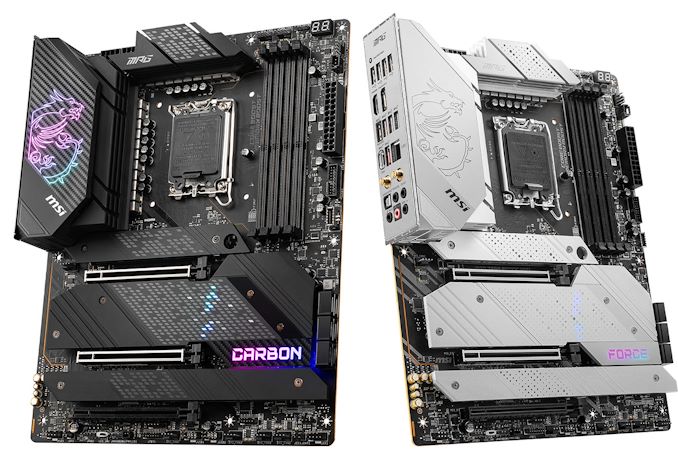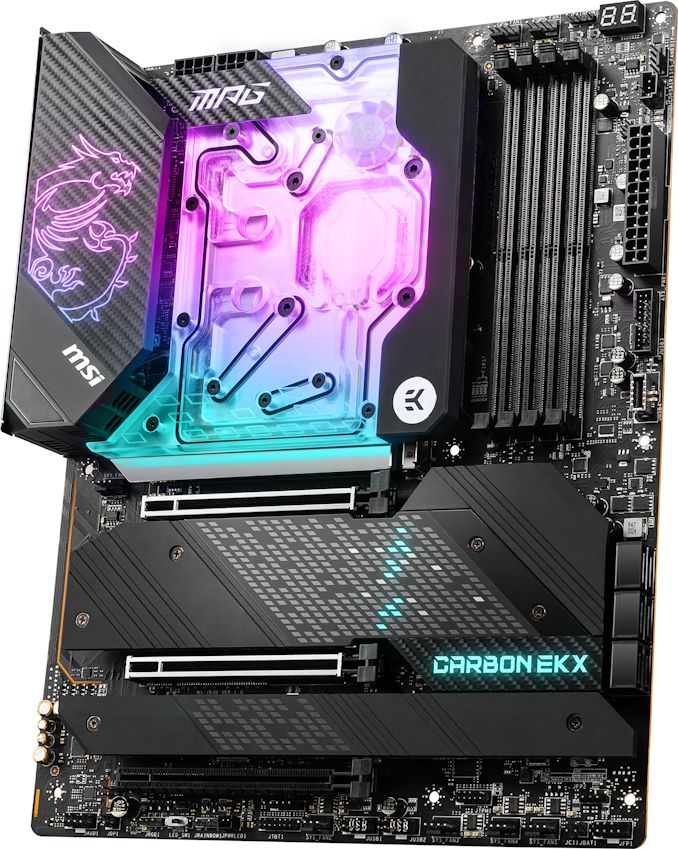The Intel Z690 Motherboard Overview (DDR5): Over 50+ New Models
by Gavin Bonshor on November 9, 2021 9:00 AM ESTMSI MPG Z690 Carbon WIFI, Carbon EK X & Z690 Force WIFI
A part of MSI's MPG (MSI Performance Gaming) series, its Carbon WIFI model returns for Z690, with a strong feature set for gamers, content creators, and everyday users. The MSI MPG Z690 Carbon WIF combines a fancy all-black aesthetic with plenty of integrated RGB LED lighting built into the rear panel cover and chipset heatsink area.
The only difference between the Carbon and the Force opts for a lighter aesthetic with a wave of silver heatsinks throughout. Both models also boast a solid networking configuration, plenty of storage options, and lots of USB connectivity. There's also an MSI MPG Z690 Carbon EK X model which includes a custom EKWB monoblock and cools the power delivery, the top PCIe 4.0 x4 M.2 slot, and the processor too. The rest of the controllers and features are shared across all three models.

The MSI MPG Z690 Carbon WIFI (left) and MPG Z690 Force WIFI (right) motherboards
Looking at PCIe support, the MSI MPG Z690 Carbon WIFI and MSI MPG Z690 Force WIFI include two full-length PCIe 5.0 slots that can operate at x16 or x8/x8, with a full-length PCIe 3.0 x4 slot. Surrounding the PCIe slots and fully covered by M.2 heatsinks, there's four PCIe 4.0 x4 M.2 slots, with a fifth PCI 3.0 x4/SATA slot for good measure. Other storage options include six SATA ports with support for RAID 0, 1, 5, and 10 arrays. In terms of memory, the board includes four memory slots capable of supporting up to DDR5-6666, with a maximum combined capacity of up to 128 GB.

The MSI MPG Z690 Carbon EK X motherboard
The MSI MPG Z690 Carbon EK X shares the exact same PCB, features, and controller set as the Carbon WIFI and Force WIFI, but it has the added benefit of a custom EKWB monoblock with integrated RGB. This is designed to offer a cheaper alternative to users looking to use custom water cooling to keep the processor cool, but the EK X monoblock also keeps the power delivery and the top PCIe 4.0 x4 M.2 slot cool too.
On the rear panel of all three models is an impressive selection of input and output, including one USB 3.2 G2x2 Type-C, five USB 3.2 G2 Type-A, and four USB 2.0 ports. A pair of video outputs including one HDMI 2.1 and DisplayPort 1.4 allows users to leverage Intel's integrated graphics, while a Realtek ALC4080 HD audio codec powers five 3.5 mm and S/PDIF optical output. For networking, MSI includes one Intel I225-V 2.5 GbE controller, as well as an Intel AX210 Wi-Fi 6E CNVi. Finishing off the rear panel is a small clear CMOS button. The only difference between both models is the Carbon/Carbon EK X has a black preattached rear I/O shield, and the Force has a silver one.











126 Comments
View All Comments
GeoffreyA - Saturday, November 13, 2021 - link
Certainly, there are tradeoffs, keeping a socket; but, as Mr. Tuvok would say, "Ryzen, you are an unending source of astonishment." There was a time when sockets even took CPUs from different manufacturers. I remember my Socket 7 motherboard, though I never tried it, could take a K5 and some Cyrix CPUs as well. Those 5x something, something. How things have changed.A short-lived socket can be a pain in the behind too. I was one of those unlucky folk who ended up with Socket 754 and missed out on dual-channel DDR and a long upgrade path. In any case, that computer went kaput after four years.
Oxford Guy - Wednesday, November 10, 2021 - link
Overclocking is for employees of motherboard companies.ECC RAM support should have been a standard feature from the beginning. Apple offered it on the Lisa in ‘83 and consumer computing has gone backward since.
Doublers, though... aren’t a bad thing as long as they’re implemented well — as I understand it. Better to have a good doubler implementation than a weak individual phase system. The main thing is to have a board meet the minimum spec for reliable (i.e. not overheating and/or failing) long-term support of its supported CPUs. Anything beyond that is unnecessary.
GeoffreyA - Saturday, November 13, 2021 - link
The problem with doublers is, they over-use it as a marketing technique to give the impression that a certain board has a large amount of phases.Oxford Guy - Saturday, November 13, 2021 - link
Weak phases with a mediocre/poor regulator aren’t necessarily better than ‘marketing phases’ via the use of doublers. That’s the case when the doublers are used a correctly.There are a lot of shenanigans, though — like not even utilizing the doubler fully but counting it as the doubling of phases. I also recall that one of the big tricks was putting extra chokes on the board to make it look like there are more phases.
GeoffreyA - Sunday, November 14, 2021 - link
Quite right, and one of the reasons why people have got to read a proper analysis of the VRM, or take a look at the lists on hardwareluxx for example.t.s - Tuesday, November 9, 2021 - link
Wish Intel go with their atv12vo. Or like business lines from HP, Dell, Lenovo, etc. 6 or 8 pin.shabby - Tuesday, November 9, 2021 - link
Mobo prices will go up even more, screw that.meacupla - Tuesday, November 9, 2021 - link
In the long term, I think the cost for ATX12VO will be cheaper.ATX12VO PSU will be cheaper than a comparable quality ATX PSU.
The BoM for 12V to 5V and 12V to 3.3V converters would go down, if mobo makers decide to stick to a single, standardized design.
With the way things are looking, electricity prices are unlikely to go down and continue to go up.
DigitalFreak - Tuesday, November 9, 2021 - link
All ATX12VO is doing is shifting the cost from the PSU to the motherboard.Wrs - Wednesday, November 10, 2021 - link
If mobo makers can stick to one design why can't PSU makers? They already conform to ATX.ATX 12 VO increases costs for piecemeal upgraders because of the simple observation that PSUs outlive motherboards. The question would be whether the power savings are worth it. For prebuilts they're comparing power savings to 0 net component cost so 12VO is already the norm.